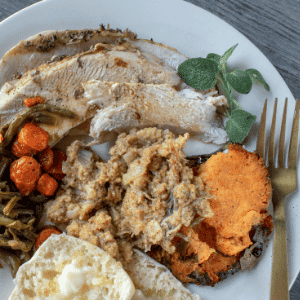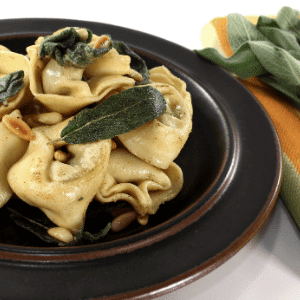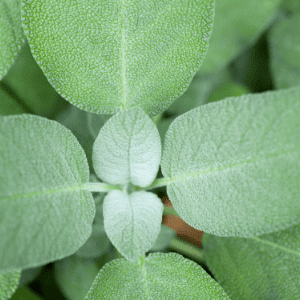Gardens, Great Meals, and Fragrant Memories
Gray/green and velvety sage leaves will enhance the taste of chicken, pork, turkey, squash, beans, and cocktails. Here’s how to use sage to add flavor and reduce sodium in your diet. See in the summary a presentation from the Mayo Clinic. Sage is a perennial member of the mint family and grows conveniently near the kitchen door. Here’s how to harvest, cook, and store your sage.
Sage-The Scent That Evokes Memory

Sage provides a true Proustian memory. It provides us with a vivid link to past celebrations.
Whenever we renew our relationship with a scent, we know in the past all the memories come too. Sage is the herb most evocative in this way. Sage is tangled in our memories of holiday meals. It brings back Thanksgiving at Grandmothers, guests with Christmas presents, and basting the turkey. It all comes back to mind as we chop and stir!
Flavor And How Sage Improves Our Meals
The taste of sage is earthy and bold. Use it in rich and hearty dishes. You will notice hints of mint and even lemon when tasting Sage. It’s a herb that we can easily grow indoors on sunny windows, which is ideal as sage is a popular ingredient for fall and winter meals.
For more information on growing and cooking with herbs read this.
How We Got Culinary Sage
Growing throughout the Mediterranean and associated with both Jupiter and immortality, it was thought to improve memory and sensory perception. It traveled throughout the Roman Empire, and the Egyptians used it medicinally, as did medieval societies. Linnaeus discussed sage.
It was used on wounds and to make women better looking. (No, sorry, I don’t have the recipe for either.)
All About Sage (Salvia officinalis)
Sage And Salvia
Salvia is a huge genus in the Lamiaceae (mint) family. It has about 1000 members. So, all edible sages are salvia, but only a few salvias are edible.
Sage-Useful In The Garden
In addition to its culinary benefits, sage helps in the following ways.
- Cover dry, stony areas where it is difficult to grow many plants
- Sage attracts pollinators
- Sage repels damaging insects such as cabbage moths, cabbage looper, cabbage maggots
- It can activate the development of compost
- Burning sage can discourage mosquitoes

Cooking With Sage
Sage has a strong flavor and aroma and should be added early in cooking. This creates a more subtle background note. If it is too subtle, you can always add a little more.
The taste of sage should be like a cooling mint; you will notice a green, sweet, floral, even hay-like note. Sage can seem both strong and bitter. I like the Chiffonade idea below; it prevents people from experiencing bitter bites.
Sage in Food Pairings
Sage’s aromatic nature blends well with cheese and cream-based meals. Use it with sweet and savory bread, potatoes, pasta, many kinds of beans, tomato sauces, and risotto.
Sage’s aromatic nature blends well with cheese and cream-based meals. Use it with sweet and savory bread, potatoes, pasta, many kinds of beans, tomato sauce, and risotto.

Sage harmonizes well with onion, garlic, oregano, parsley, and bay leaf. Use it with thyme, rosemary, and marjoram. I found this article suggesting pairings of food and sage. Some of them might surprise you.
Using Sage Leaves From Your Garden
Sage leaves add flavor at any stage of the plant’s life. Most herbs develop a bitter taste after the plant flowers. This is not true of sage; use it any time. Trim the plant regularly, as you would any herb. This will prevent it from developing a thick woody stem, which is negative for flavor.

Cut the leaves with scissors or a sharp blade. Remove the leaves from the stems, rinse in cold water, and pat dry. According to your recipe, you can chop or mince them or slice them into a chiffonade.
Make A Chiffonade From Your Sage Leaves
Remember the three steps: stack-roll-slice. Stack your leaves, roll them like a little cigar, and slice them into narrow diagonal strips. This ensures that the flavor can be evenly distributed in your dish, and it does not hurt that it looks like a great chef made it!
Recipes and Ideas
Fried Sage Leaves
I love to make these float-on soups. They add a savory crunch. Just make some and put them out with drinks. Remember to get your share first! Here is a recipe from Saveur.com
Roast Turkey With Sage Butter
Roast turkey with sage stuffing is a popular holiday dish. This one makes delicious butter from the sage. I made it one year for Thanksgiving and am still resting on the laurels. From Food Network, Tyler Florence.
Growing Sage In Your Garden for Your Kitchen
Planting
Plant Sage in medium to full sun after the ground temperature reaches 65 degrees. Sage is a woody perennial in zones 4-9. We have learned that if garden sage survives our humid zone 10 summers it will easily survive the winter.
Garden sage accepts well-drained soil amended with organic matter. Place the new plants in a hole about two times the width of the nursery pot and as deep. If your soil is heavy, slow draining or very acidic amend it with lighter materials.
The top of the plant should be equal to the surrounding soil. Sage is subject to mildew diseases, ensure that you follow the spacing instructions on the pot you have bought. Plants growing too close together do not have sufficient air circulation and are subject to disease. We gardeners, do live for a long time with decisions we make on planting day.
Growing Sage Indoors For The Winter
Ensure that the plant is potted in quality, sterile potting soil. This article discusses what to look for in purchasing a potting mix. Sage requires 6-8 hours of sun. A sunny south-facing window should suffice, otherwise, you may need a grow light.
Water and Fertilizer
Especially if you love sage, avoid too much generosity with food and water. Overfeeding and watering will negatively affect the flavor of the leaves. Put your finger in the soil, if it is dry for an inch you can water it safely. Fertilize one month after planting. Sage grows best with a pH of 6-7.
Pruning and Harvesting Your Garden Sage Plant
Start early in the life of your plant and prune it to maintain a bushy, mounded shape. It is a woody perennial, and we want to maintain loads of tender new foliage. Trim back the woody stems in spring. Cut about 1/2 of the stems back to the base of the plant and prune the other half to about 1/3 of their length. The entire plant can be safely cut back by a maximum of 1/3 of its volume.
After several years, the plant may become woody. Many gardeners can extend the plant’s life (after five years) by a severe trimming.
Pests And Diseases of Sage Plants
Pests: be observant and notice the presence of Aphids, Thrips, and Whitefly, These are tiny, clear, sucking insects. They are hard to see but they will be on the underside of leaves. There will also be a sticky substance on the leaves.
This is a piece on managing Aphids from the University of California
This discusses Thrips from UC Davis
This should be helpful for Whiteflies from the University of Florida
Being proactive is the easiest way to handle the problem. Remove the creatures with water or soap, pick off damaged leaves. A hard spray from the hose can be useful. If that fails, insecticidal soaps can be helpful.
As I write this we are having a late tropical storm, (our first November storm in over 20 years.) I need to be proactive in the garden, ruthless removal of damaged leaves makes a big difference.
Beneficial Insects
Some plants attract beneficial insects that can solve the problem. You might like this article on sweet Alyssum and its partner in crime the hoverfly.
Companion Plants For Sage
Companion planting can help to deter pests, stimulate growth, and attract beneficial insects.

- Plant sage near members of the cabbage family. It repels pests common to these vegetables such as broccoli, kale and cauliflower
- Plant near carrots and it will repel carrot rust flies\
- It can improve the flavor of strawberries and deter it’s pests
- Sage will attract beneficial insects to nearby tomatoes
- Plant with rosemary as it is one of few herbs to perform well with rosemary
Varieties Of Garden Sage To Choose From
Berggarten
The name is German for mountain garden and it has some unique advantages you may like. The hardiness zone is broad, 5-11, the foliage is a lovely silver gray and it is large. It rarely blooms which extends its useful life. It grows to 16″ H and 24″W.
If you like to fry sage leaves the big ones are nice to work with.
Golden Sage
This one has a lovely variegated leaf, the foliage is cream-colored with irregular patches of a like green color. It grows as a small shrub of 2′ H and 1’W. This variety is hardy to zones 5-11.
Purple Sage
Ornamental as well as edible purple sage grows in a full sun environment. The narrow, purple leaves have a grayish underside. It usually is advisable to prune and discourage flower and seed growth, but this plant has beautiful purple flowers. So it offers a choice of flowers or lots of dinners. It will grow 12″-24″ tall and wide. Purple Sage is hardy to zones 6-9.
Tricolor Sage
This ornamental sage has strongly aromatic leaves colorful grayish-green leaves that are marbled with white, purple, and pink. The leaves are edible both fresh and dried. The taste combines rosemary and pine with a bit of citrus. Tricolor Sage is hardy in zones 6-9.
Summary Using Sage-Garden to Kitchen,
Flavorful, healthy, and cost-effective, cooking with herbs fresh from your garden has so many benefits that I truly hope that everyone tries this out. This piece is the Mayo Clinic’s opinion on using herbs and spices.
It seems simplistic to say that a pot of herbs near the kitchen door can change for the better the way that we eat, but it is true. Sage is an easy-to-grow plant that will enhance the way you eat. The Ancient Romans named it for the word Salvere, to be saved.
At one time the French raised sage to make tea, it was also profitable because the Chinese, who understood tea would trade three times the amount of their own tea to get the French sage tea!
So grow some sage, you may not make a profit from it but you will appreciate it!
Resources
This article discusses Culinary Herbs and will provide information about other herbs to use with Sage.
Thyme, Marjoram, and Rosemary are other herbs that blend successfully with Sage. These are links to information about the herbs.
Resources You Can Use:
‘Sage advice for Herbs: Savory from Garden to Kitchen.’
